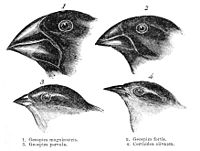
Photo from wikipedia
Abstract Individuals within natural populations can experience very different abiotic and biotic conditions across small spatial scales owing to microtopography and other micro-environmental gradients. Ecological and evolutionary studies often ignore… Click to show full abstract
Abstract Individuals within natural populations can experience very different abiotic and biotic conditions across small spatial scales owing to microtopography and other micro-environmental gradients. Ecological and evolutionary studies often ignore the effects of micro-environment on plant population and community dynamics. Here, we explore the extent to which fine-grained variation in abiotic and biotic conditions contributes to within-population variation in trait expression and genetic diversity in natural plant populations. Furthermore, we consider whether benign microhabitats could buffer local populations of some plant species from abiotic stresses imposed by rapid anthropogenic climate change. If microrefugia sustain local populations and communities in the short term, other eco-evolutionary processes, such as gene flow and adaptation, could enhance population stability in the longer term. We caution, however, that local populations may still decline in size as they contract into rare microhabitats and microrefugia. We encourage future research that explicitly examines the role of the micro-environment in maintaining genetic variation within local populations, favouring the evolution of phenotypic plasticity at local scales and enhancing population persistence under global change.
Journal Title: AoB Plants
Year Published: 2020
Link to full text (if available)
Share on Social Media: Sign Up to like & get
recommendations!